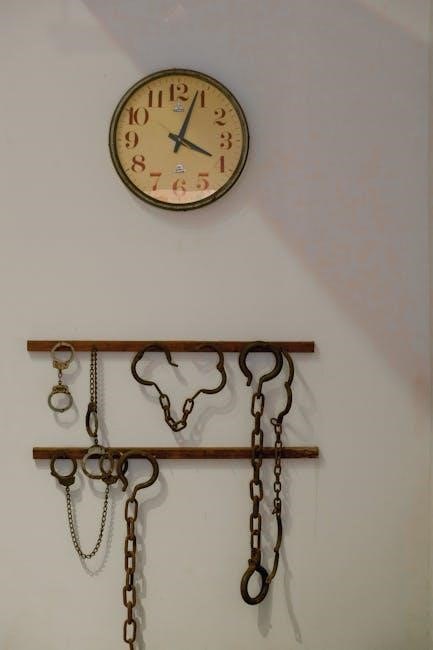Welcome to the Stihl Bar and Chain Catalog, your comprehensive guide to selecting the right equipment for optimal performance and safety. This catalog provides detailed information on guide bars, chains, and their compatibility with various Stihl chainsaws, ensuring you make informed decisions. With a focus on safety, quality, and precision, the catalog helps you navigate the wide range of options tailored to your specific needs, from forestry work to everyday tasks. Explore the features, specifications, and expert recommendations to enhance your cutting experience.
1.1 Overview of the Catalog
The Stihl Bar and Chain Catalog is a comprehensive guide designed to help users select the ideal guide bar and chain for their specific needs. It features detailed product listings, including specifications, compatibility charts, and safety information. The catalog is organized to simplify the selection process, ensuring users find the perfect match for their chainsaw model. It highlights key features such as reduced-kickback chains, ANSI standards, and maintenance tips. Whether you’re a professional or a homeowner, the catalog provides clear, user-friendly information to enhance performance, safety, and efficiency. Its structured layout makes it easy to navigate and understand.
1.2 Importance of Using Genuine Stihl Parts
Using genuine Stihl parts ensures optimal performance, safety, and durability for your chainsaw. Genuine bars and chains are designed to meet strict safety standards, reducing kickback risks and improving control. They are precision-engineered to fit seamlessly with Stihl chainsaws, delivering consistent cutting efficiency. Counterfeit or non-genuine parts may compromise safety and performance. Genuine Stihl components are built to last, minimizing wear and tear, and are backed by warranty. Investing in authentic parts protects your equipment, enhances productivity, and ensures compliance with ANSI B175.1 standards. Prioritize safety and reliability by choosing genuine Stihl bars and chains for your chainsaw.
Understanding the Stihl Bar and Chain Catalog
The Stihl Bar and Chain Catalog is designed to help users find the perfect fit for their chainsaws. It features detailed specifications, compatibility guides, and safety standards like ANSI B175.1, ensuring enhanced performance and safety. The catalog highlights key features such as low-kickback chains and color-coded systems, making it easier to identify the right parts for your needs. By referencing this guide, you can optimize your chainsaw’s efficiency and reliability, ensuring a seamless cutting experience across various tasks and conditions.
2.1 Structure of the Catalog
The Stihl Bar and Chain Catalog is organized to provide easy navigation and quick access to essential information. It begins with an overview of guide bars and chains, highlighting their types, sizes, and materials. Detailed sections cover technical specifications, such as bar lengths, chain pitch, and gauge, ensuring compatibility with specific chainsaw models. The catalog also includes safety standards like ANSI B175.1 and color-coded systems for kickback reduction. Additional resources, such as a selector tool, maintenance tips, and troubleshooting guides, are integrated to help users make informed decisions and optimize their equipment’s performance.
2.2 Key Features and Specifications

The Stihl Bar and Chain Catalog details essential features and specifications to ensure optimal performance. Guide bars are categorized by type, length, and material, with options for tasks like logging, pruning, or carving. Chains are highlighted by their pitch, gauge, and tooth style, designed for efficiency and durability. Safety features, such as low-kickback chains with green tie straps, are emphasized, meeting ANSI standards. Each product’s specifications are clearly outlined, helping users match the right bar and chain to their chainsaw model for maximum efficiency and safety in various cutting applications.
2.3 Benefits of Referencing the Catalog
Referencing the Stihl Bar and Chain Catalog ensures accurate selection of guide bars and chains, optimizing performance and safety. It provides detailed compatibility information, helping users match components to their chainsaw model. The catalog highlights safety features like low-kickback chains and ANSI standards, reducing injury risks. By understanding chain specifications and bar types, users can enhance cutting efficiency and durability. It also serves as a troubleshooting guide for common issues, ensuring proper maintenance and extending equipment lifespan. This resource empowers users to make informed decisions, avoiding costly mistakes and ensuring their Stihl equipment operates at its best.

How to Choose the Right Stihl Bar and Chain
Choosing the right Stihl bar and chain involves understanding your chainsaw’s needs, matching the bar length, and selecting the appropriate chain type for your cutting tasks. Proper compatibility ensures optimal performance and safety, while adhering to ANSI standards reduces kickback risks. Always consult the catalog for precise specifications and expert recommendations tailored to your equipment and application.
3.1 Types of Stihl Guide Bars
Stihl offers a variety of guide bars designed for different cutting tasks and chainsaw models. The Rollomatic and Super Rollomatic bars feature a replaceable sprocket nose for extended life, while the Non-Rollomatic bar is cost-effective for lighter use. Each bar type is engineered to optimize performance, durability, and safety, ensuring precise cutting and reduced wear on the chainsaw. By understanding the specific features and applications of each bar type, users can select the ideal match for their needs, enhancing both efficiency and results in various cutting scenarios.
3.2 Types of Stihl Chains

Stihl chains are designed to meet diverse cutting needs, offering options for efficiency, safety, and durability. The PMM (Power Matched) chain is optimized for specific chainsaw models, ensuring maximum performance. The PICCO chain is ideal for precision cutting tasks, while the RMC (Rapid Micro) chain excels in high-speed cutting. Additionally, Stihl offers low-kickback chains with green tie straps, meeting ANSI standards for reduced kickback risk. Each chain type is engineered for specific applications, ensuring users can choose the right chain to match their bar and saw, enhancing both productivity and safety in various cutting environments.
3.3 Matching the Bar to Your Chainsaw Model
Correctly matching the guide bar to your chainsaw model is essential for optimal performance and safety. Stihl guide bars are designed to fit specific chainsaw models, ensuring compatibility and efficiency. The bar length, type, and features must align with your chainsaw’s specifications to maintain balance and cutting precision. Referencing the Stihl Bar and Chain Catalog or using the online selector tool helps identify the ideal bar for your saw. Proper matching ensures smooth operation, reduces wear, and enhances cutting accuracy, making it crucial for achieving professional results in various applications, from logging to landscaping.
3.4 Understanding Chain Specifications
Understanding chain specifications is vital for ensuring proper fitment and performance. Stihl chains are categorized by type, such as PMX, PMN, and PS, each designed for specific tasks. Parameters like chain length, pitch, gauge, and number of drive links must match your chainsaw and guide bar. The ANSI B175.1 standard identifies low-kickback chains with a green tie strap, while yellow marks indicate higher kickback risk. Referencing the catalog or using the selector tool helps decode these specs, ensuring compatibility and safety. Proper chain selection enhances cutting efficiency, reduces wear, and minimizes kickback hazards, making it a critical step in optimizing your chainsaw’s performance.
3.5 ANSI B175.1 Chain Saw Kickback Standard
The ANSI B175.1 standard sets guidelines for chain saw kickback reduction, ensuring safer operation. Stihl chains meeting this standard feature a green tie strap, indicating reduced kickback risk. Chains without this marking, often identified by yellow color coding, may pose higher kickback risks. The standard helps users identify products designed for safety, particularly for inexperienced operators. By adhering to ANSI B175.1, Stihl ensures compliance with industry safety protocols, providing users with reliable tools that balance performance and protection. Always look for these identifiers when selecting chains to enhance your safety and meet regulatory requirements.
Using the Stihl Guide Bar and Saw Chain Selector Tool
The Stihl Guide Bar and Saw Chain Selector Tool helps users find the perfect bar and chain combination by asking specific questions about their chainsaw model and needs.
4.1 How the Selector Tool Works
The Stihl Guide Bar and Saw Chain Selector Tool operates by guiding users through a series of questions about their chainsaw model, bar length, and application. This information helps narrow down compatible options. The tool then recommends specific bars and chains based on the input, ensuring optimal performance and safety. It streamlines the selection process, making it easier for both professionals and DIYers to find the right equipment. By leveraging this tool, users can quickly identify the best match for their needs without sifting through the entire catalog manually;
4.2 Benefits of Using the Selector Tool
Using the Stihl Guide Bar and Saw Chain Selector Tool offers numerous advantages, saving time and ensuring compatibility. It simplifies the selection process by narrowing down options based on your specific needs, reducing confusion. The tool enhances safety by recommending equipment that meets ANSI standards and reduces kickback risks. It also improves efficiency, as users can quickly find the right bar and chain without manual searching. Whether you’re a professional or a first-time buyer, the tool provides confidence in your choices, ensuring optimal performance and longevity of your chainsaw. This streamlined approach makes selecting the right parts faster and more accurate.
Maintenance and Sharpening of Stihl Chains
Proper maintenance and sharpening of Stihl chains are essential for optimal performance and safety. Regular cleaning, sharpening, and lubrication ensure durability and efficiency, preventing premature wear and tear.
5.1 Best Practices for Chain Maintenance
Regular chain maintenance is crucial for extending the life and performance of your Stihl chains. Always clean the chain thoroughly after use to remove debris and sap, which can cause corrosion. Proper lubrication is essential to reduce friction and prevent overheating. Use Stihl’s recommended bar and chain oil to ensure compatibility and optimal performance. Additionally, inspect the chain for wear and damage, such as dull cutters or broken links, and address these issues promptly. Following these best practices will ensure your chain operates efficiently and safely, maximizing your chainsaw’s effectiveness.

5.2 How to Sharpen a Stihl Chain
Sharpening your Stihl chain is essential for maintaining optimal cutting performance and safety. Always use the correct file size, as specified in your chain’s manual, to avoid altering the cutter’s shape. Maintain the recommended cutter and depth gauge angles to ensure proper cutting efficiency. Use a Stihl chain sharpener or a high-quality file guide to achieve precise sharpening. Regularly inspect the chain for wear and dullness, sharpening as needed. Improper sharpening can lead to reduced performance and increased kickback risk, so follow Stihl’s guidelines carefully or consult a professional for assistance.
5.3 Importance of Proper Lubrication
Proper lubrication is crucial for maintaining the performance and longevity of your Stihl chain and bar. Regularly applying high-quality bar oil reduces friction and prevents overheating, ensuring smooth operation. Insufficient lubrication can lead to premature wear, increased risk of damage, and reduced cutting efficiency. Always use Stihl-approved bar oil to protect your equipment from corrosion and extend its service life. Consistent lubrication also helps maintain chain tension, preventing slackening or over-tightening issues. By prioritizing proper lubrication, you safeguard your chainsaw’s components and ensure reliable performance for demanding cutting tasks.

Identifying the Correct Replacement Parts
Identifying the right parts requires decoding bar numbers, matching chains to your saw, and checking ANSI standards and color codes for proper fitment, reduced kickback, and safety.
6.1 Decoding the Numbers on Your Stihl Bar
Decoding the numbers on your Stihl bar is essential for identifying the correct replacement parts. The bar typically features a series of markings, such as 20 ⎯ 72x ー 0.063 ー 3/8, which provide crucial information. The first number represents the bar length, while the second indicates the chain type and pitch. The third number refers to the chain gauge, and the last specifies the drive link size. Understanding these codes ensures compatibility with your chainsaw model and chain specifications, helping you avoid mismatches and potential safety risks. Referencing the Stihl catalog or using the selector tool can further simplify this process.
6.2 How to Identify the Correct Chain for Your Saw
To identify the correct chain for your saw, start by checking the bar markings, which provide key details like chain type, pitch, and gauge. The chain length is determined by the bar size, while the pitch and gauge must match your saw’s specifications. Look for ANSI B175.1 standards, as low-kickback chains are marked with a green tie strap. Always refer to the Stihl catalog or use the selector tool to ensure compatibility. Matching the chain to your bar and saw model is crucial for safety, performance, and reducing kickback risks. Proper identification ensures optimal cutting efficiency and equipment longevity.
6.3 Troubleshooting Common Chain Issues
Common chain issues often arise from improper fit, excessive wear, or incorrect sharpening. Check if the chain is compatible with your bar length and type, as mismatched components can cause poor performance. Inspect for worn or damaged teeth and ensure proper tension to prevent slippage. Sharpen chains regularly, using the correct file size, to maintain cutting efficiency. Refer to the Stihl catalog for guidance on addressing specific problems, such as kickback or uneven wear. Proper maintenance and timely replacements are key to ensuring safety and optimal performance. Always follow Stihl’s recommendations for troubleshooting and resolving chain-related challenges effectively.

Safety Considerations
Adhering to ANSI B175.1 standards is crucial for reducing kickback risks. Always use genuine Stihl parts and ensure proper chain maintenance to enhance safety and performance.
7.1 Understanding Kickback Reduction Features
Stihl bars and chains incorporate advanced kickback reduction features, including green tie straps on low-kickback chains that meet ANSI standards. These designs minimize kickback risks, enhancing safety for both experienced users and newcomers. Yellow marks indicate higher kickback potential, aiding in quick identification. Proper chain maintenance and bar alignment are also vital for reducing hazards. Always refer to the catalog for guidance on selecting the right equipment to ensure safe and efficient cutting operations.
7.2 Safety Standards for Stihl Bars and Chains
Stihl bars and chains are designed to meet rigorous international safety standards, ensuring reliability and protection for users. The ANSI B175.1 standard for chain saw kickback reduction is a key benchmark, with features like low-kickback chains and color-coded systems (green for reduced kickback, yellow for caution). These components undergo extensive testing to ensure durability and performance under various conditions. Stihl’s commitment to safety is evident in their adherence to these standards, providing users with equipment that minimizes risks while maintaining high cutting efficiency. Always prioritize these safety features when selecting your bar and chain.
7.3 Safe Usage and Handling Practices
Proper handling and usage of Stihl bars and chains are essential for safe and effective operation. Always inspect the bar and chain for damage or wear before use. Ensure the chain is properly tensioned and lubricated to prevent accidents. Wear personal protective equipment, including gloves, safety glasses, and a helmet. Maintain a firm grip on the chainsaw and avoid cutting in unsafe positions. Follow the manufacturer’s guidelines for sharpening and maintenance. Never use a damaged or dull chain, as it can increase the risk of kickback. Regularly clean and store the bar and chain to maintain their performance and longevity.
Comparing Stihl Bars and Chains to Other Brands
Stihl bars and chains are known for their superior quality, durability, and innovative features. Compared to other brands, Stihl stands out for its low-kickback technology and precision engineering.
8.1 Key Differences in Quality and Performance

Stihl bars and chains excel in quality and performance due to their precise engineering and high-grade materials. Unlike other brands, Stihl offers low-kickback chains with ANSI certification, enhancing safety for all users. The guide bars are designed for durability, catering to various cutting tasks, from heavy logging to precise pruning. Stihl’s innovative features, such as the green tie strap for low-kickback identification, set them apart. Their chains are built to maintain sharpness longer, reducing maintenance needs. This commitment to excellence ensures Stihl products consistently deliver superior cutting efficiency and reliability compared to other brands, making them a top choice for professionals and enthusiasts alike.
8.2 Cost and Value Comparison
Stihl bars and chains are often considered a higher investment compared to other brands, but they offer exceptional durability and performance. While the initial cost may be higher, their long-term reliability and reduced maintenance needs provide significant value. Stihl’s commitment to quality ensures that their products outlast many competitors, making them a cost-effective choice over time. Additionally, Stihl’s comprehensive warranty and safety features, like low-kickback technology, add to the overall value. For professionals and serious users, the superior performance and longevity of Stihl parts justify the investment, making them a top choice for those prioritizing durability and efficiency.

Frequently Asked Questions
Common questions include finding the correct chain, understanding bar codes, and ensuring compatibility. Users often ask about durability, performance, and safety features. This section provides clear answers.

9.1 Common Questions About Stihl Bars and Chains
Users often inquire about identifying the correct chain for their saw, decoding bar numbers, and understanding kickback standards. Many ask about chain sharpening techniques and lubrication best practices. Others seek advice on choosing between different bar types and chain pitches. Additionally, questions about compatibility with specific chainsaw models and troubleshooting common issues are frequent. This section addresses these concerns, providing clear guidance and solutions to ensure optimal performance and safety.
9;2 Tips for First-Time Buyers
For first-time buyers, understanding your chainsaw model and its compatibility with bars and chains is crucial. Start by reviewing the Stihl Bar and Chain Catalog to match your saw’s specifications. Consider the type of cutting you’ll be doing most often to choose the right bar length and chain pitch. Always prioritize safety by selecting low-kickback chains, especially if you’re new to chainsaws. Use the Stihl Guide Bar and Saw Chain Selector Tool for personalized recommendations. Additionally, invest in proper maintenance tools, such as sharpening files, and follow lubrication guidelines to extend the life of your equipment.
The Stihl Bar and Chain Catalog is an essential resource for optimizing your chainsaw’s performance and safety. By following its guidance, you can ensure proper fitment and reliability, enhancing your cutting experience while adhering to safety standards. Always refer to the catalog for accurate information and explore additional resources for continued learning and improvement in your woodworking or forestry tasks.
10.1 Final Thoughts on Using the Catalog
Using the Stihl Bar and Chain Catalog is essential for ensuring optimal performance, safety, and longevity of your chainsaw. By referencing the catalog, you can confidently select the right bar and chain combination tailored to your specific needs. Proper fitment enhances cutting efficiency and reduces wear on your equipment. Always prioritize safety by adhering to the ANSI B175.1 standard and understanding kickback reduction features. Trust Stihl’s expertise to guide your decisions, and rely on the catalog as your go-to resource for maintenance, troubleshooting, and upgrading your chainsaw setup. This comprehensive guide is your key to unlocking peak performance and reliability.
10;2 Encouragement to Explore More Resources
Exploring additional resources beyond this catalog can further enhance your understanding and use of Stihl bars and chains. Visit the official Stihl website for detailed guides, instructional videos, and troubleshooting tips. Utilize the STIHL Guide Bar & Saw Chain Selector Tool for personalized recommendations. Additionally, consult maintenance guides, safety manuals, and FAQs to address specific concerns. Engaging with Stihl’s online community and authorized dealers can also provide valuable insights and support. By leveraging these resources, you’ll ensure optimal performance, safety, and longevity of your chainsaw, making every cutting task more efficient and enjoyable.



